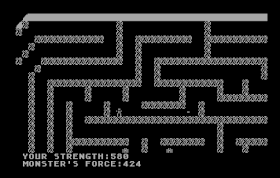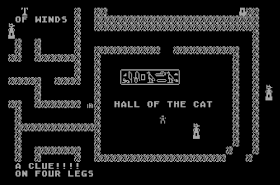 |
As we'll see, the game would have been more properly called In the Sphinx.
|
Beneath the Pyramids
United States
Crystalware (developer and publisher)
Released in 1980 for Apple II, 1981 for Atari 800
Date Started: 10 June 2019
Date Finished: 10 June 2019
Total Hours: 3
Difficulty: Easy (2/5)
Final Rating: 15
Ranking at time of posting: 45/332 (14%)
As I continue to work my way through the Crystalware catalog (we started with House of Usher), it's appearing that many of the titles issued by this prolific developer use the same base programming, which in turn looks a lot like a low-rent version of Dunjonquest. (Ironically, Epyx, the makers of Dunjonquest, would eventually republish a lot of Crystalware titles.) Even if I'm wrong about that influence the games are certainly self-referential. Beneath the Pyramids feels a lot like House of Usher with a few added features.
 |
| In the pyramid. A treasure awaits in the Hall of Gods and a mummy awaits in the corridors. |
The setup here is that it's 1932, and you're an agent of the British Museum, sent to Giza to search for a priceless artifact: a solid gold statue of the ancient cat goddess, Bast. The first paragraph of the backstory says that you're looking for it within the Great Pyramid but the second says that you're searching within the Sphinx. The distinction becomes important later.
 |
| The brief backstory. |
At the beginning of the game, you have the option to purchase a number of items at "the bazaar," where for some reason you're spending gold pieces. Limited by wealth and weight, you can't quite buy everything. Through trial and error, I determined that you want, at minimum, a rifle with about 20 bullets, a crowbar, a duffel bag (which increases carrying capacity), a grapple, a lantern, a gas mask, and at least one pick-axe.
 |
A shop, an inventory, and more complex commands distinguish this game from House of Usher.
|
From here, you "enter the Sphinx." The first level is indeed shaped somewhat like the Sphinx, with long corridors on the right and left sides jutting south, corresponding with the statue's legs. Nonetheless, as you ascend in the structure, the levels become smaller and square, as if you were going up a pyramid. The first level is about four screens wide and maybe five tall. As you move, the screen scrolls rather than changing abruptly when you hit the edge (at least in the Atari 800 version; I read that the Apple II version uses fixed rooms).
 |
| Starting outside the pyramid. The Sphinx's paws are off-screen to my right and left. I know those sentences don't make sense. |
The levels are structured like mazes, with plenty of dead ends. Treasures and monsters are scattered randomly through the structure, which otherwise has a fixed layout.
You start with 1,000 energy, and your goal is to find the cat and get out before you run out. Energy depletes in combat but also just from the passage of time. You have a health score that really seems more like a measure of your offensive effectiveness; enemy attacks deplete not "health" but energy. You also have a defense score. Both are adjusted by items that you find in the maze. You also find plenty of treasures, which increase your final score.
Enemies are properly thematic; they include mummies, sand fleas, leeches, desert rats, and cobras. Combat has not evolved since House of Usher. Although you can find weapons like battle axes and spears in the maze, it's clear that these items simply add to your effectiveness. The only weapon you can actually employ is the rifle. The joystick button fires a bullet in the last direction that you moved. If you're going to kill enemies, you really want to get them in a long corridor with limited lateral movement, because once they get in melee range they dart all around you and it's nearly impossible to shoot them.
 |
| Shooting a leech where he can't avoid me. |
I say "if you're going to kill enemies" because it's hardly necessary. It's easy enough to run past most of them, and they eventually just disappear. Apparently, combat is easier in the Apple II version but fleeing is harder, because the character and the monsters take turns moving.
As you explore, you randomly run into other menaces for which you need equipment. You might knock over an urn and release poison gas; that's a job for the gas mask. If a statue falls on you, you pry it off with the prybar. If it suddenly goes completely dark, you light your lantern. And so forth.
 |
| A handy gas mask saved me from poison. |
The maze can be quite frustrating, but you can make it a lot easier with the pick-axe, which burrows through walls. It breaks after a few uses, though, and you need to save at least one use for the top level.
You occasionally come across chambers labeled things like "Hall of the
King," "Room of Mysteries," "Chamber of Lost Souls," and so forth. Each one
of these has an ankh cross in the room, and touching the cross either
activates a trap, grants you a treasure, or gives you a clue.
 |
| Is it maybe . . . a cat? |
Here are the clues I received:
- What goes out in the morning
- Four stone stairways
- Search for a golden cat
- Through the doorway of the Ka
- On four legs
- Comes back in the evening
"Four stone stairways" refers to the fact that you have to ascend four times (using your grappling hook) to reach the final level. Most of the other clues seem to be hinting at a cat, although I have no idea what "through the doorway of the Ka" means except that it's a (dead-end) room on the third level. You would need these clues, maybe, if the game hadn't explicitly told you that your goal was to find the cat statue.
 |
| Nothing special happened in this room. |
The fourth level has the "Temple of Bast," where you at last find the cat statue. From there, you just have to reverse direction and head back to the entrance on the first floor.
 |
| Almost there. |
Once you reach it, however, the game has a surprise for you. A "guardian" appears and says, "what say you to my riddle?" If you get it wrong, you're "killed and eaten."
 |
| Note that the metrics below do not constitute a single "score." |
At first, I thought the "clues" must have something to do with the riddle, and I tried CAT, DOG, and several other possibilities to no avail. Later, after I'd given up and started composing this entry, it occurred to me that the game might be referring to
the riddle of the Sphinx. I reloaded, grabbed the statue, answered MAN, and won.
 |
| I suspect I'm not the first, or I'd go for that prize. |
If this seems a bit unfair, it's entirely possible that the game manual included the riddle or an allusion to it. I haven't been able to find the original manual. (The MoCAGH's version just has a blank page inside.)
The Atari 800 version allows you to save your game in progress, but honestly, if you need it, it's time to get that bladder infection checked out. The game takes no more than a half hour from beginning to end even if you get lost. It scores a low 15 on the GIMLET, with 1s and 2s in most categories.
I'll get to the rest of the Crystalware titles eventually, but probably not all in order because I don't want to test everyone's patience, least of all my own. There's a reason that this catalog went unremembered for so long.
Still, now that we've had some experience with a couple of them, it's worth talking about
Dragon Lair, a 1981 Japanese release that may be the first Japanese RPG, beating
Dragon and Princess (1982) by a year. The title was released for the PC-88 and the FM-7 and was written by John and Patty Bell, co-authors of most of the Crystalware titles (only John is credited on
Beneath the Pyramids, however). Sam Derboo at Hardcore Gaming 101
covered Dragon Lair back in 2016, and its mechanics sound a lot like
Beneath the Pyramids even if its graphics are a little more primitive. Now that we have a foundation with their earlier games, I've added it to my list to investigate.
That was a short one. Back we go to the modern list with the first sequel to
Telnyr.
**********
Today's entry was originally going to be about Danger in Drindisti (1982), the last Dunjonquest title, but I can't see to solve a puzzle on Level 7 involving glass statues. I can't imagine that anyone has, but if anyone has played this game and found the Glass Wizard's lair on Level 7, please give me a hint.














I wonder if there's a sequel, in which you're an agent of the Museum of Cairo, sent to England to search for Cnut's crown.
ReplyDeleteYou'd have to break into Winchester Cathedral and rummage through the mortuary chamber.
The clues "What goes out in the morning," "On four legs," and "Comes back in the evening" sound like parts of the classic Sphinx riddle. I'm guessing that the remaining parts are also available as clues scattered throughout the game - so that when all are put together they make something like, "What goes out in the morning, On four legs, Walks at noon, On two legs, Comes back in the evening, On three legs." This would mean the final riddle challenge is solvable (theoretically) without outside knowledge.
ReplyDeleteI think you're probably right, and I feel a bit foolish for overlooking that possibility, although the "goes out" and "comes back" parts add unnecessary and nonsensical clauses to the riddle.
DeleteVoltgloss is right, at least in Apple II version, you can get all parts of the classic sphinx riddle as clues, but the treasures are ramdomized each time you enter a room, so it could take some time.
DeleteAbout the other clues, they direct you to the Temple of Bast and her statue. In Apple II version you enter the pyramid through a tunnel below the sphinx, then climb to the top using the stairs. The last stairs, leading to the Temple of Bast, are in the Doorway of the Ka room.
That's all about the mystery (in Apple II version it makes clear that escaping with the statue is solving the mystery and tells the player to write Crystalware explaining how he got the correct answer to the riddle).
Ah, and in Apple II version you can escape the dungeon if you have treasures worth above 3.000, selling them and losing your old equipment, you are given another oportunity to buy new equipment with the earned money to enter the sphinx again.
"Beneath the Pyramids" is the title of an HP Lovecraft story (Harry Houdini hired him to ghostwrite it!). Between this and "House of Usher", I'm sensing a theme.
ReplyDeleteThat's what I thought of when I saw the game's title too!
DeleteIt's really cool that you're playing these.
ReplyDeleteI think these games look pretty interesting. Especially compared to a lot of the other games of similar age and notoriety covered on this blog. They might not play well, but they seem like they had some thought that went into them, and the survival mechanics seem genuinely novel.
DeleteYeah, these were even slightly before my time. It's very interesting to see what was happening.
DeleteIf it had been released for the commodore 64, I probably would have played it :P
DeleteI heard already an old rumor about a secret passage that goes from the Sphinx to the Pyramids.
ReplyDeleteOf course, it is just a rumor: the Pyramids are buildings, but the Sphinx is a sculpture (the brick paws are a later restoration). In order to create such secret passage, the sculptors of the Sphinx should have dug through hundreds of meters/yards of solid rock. Simply impossible.
For anyone interested in the Giza Pyramids (also including the Sphinx), I recommend Jimmy Maher's series about themstarting here over at the Analog Antiquarian (sister site to his Digital Antiquarian) where he writes 'Chronicles of worldly wonders'.
DeleteI read the whole ebook and learned a lot about the discovery of their secrets, their role in history, what is known about their background and construction, many different players in these aspects etc., in an entertaining way.
The mystery seems to be something different, unlinked to the fact that you won... Otherwise, they wouldn't say "IF you know what the mystery is".
ReplyDeleteOf note, I recently found a working Apple II versions of The Crypt and partially working copy of House of Usher online. The Atari versions are superior, though. You can see screenshots on Mobygames.
ReplyDeleteIs that another Crystalware game? Because "The Crypt" is another Lovecraft story. Definitely a theme.
DeleteThe "Hall of Amenhotep IV" has Cleopatra's name on the wall. So do all the other places with hieroglyphics. I didn't know the queen of the Nile was such a prolific graffiti artist!
ReplyDelete